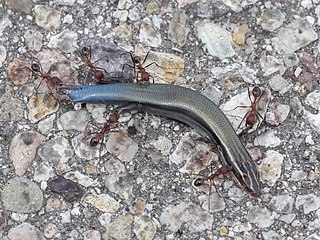
Skinks are lizards belonging to the family Scincidae, a family in the infraorder Scincomorpha. With more than 1,500 described species across 100 different taxonomic genera, the family Scincidae is one of the most diverse families of lizards. Skinks are characterized by their smaller legs in comparison to typical lizards and are found in different habitats except arctic and subarctic regions.

Carlia is a genus of skinks, commonly known as four-fingered skinks or rainbow skinks, in the subfamily Eugongylinae. Before being placed in this new subfamily, Carlia was recovered in a clade with the genera Niveoscincus, Lampropholis, and others of the Eugongylus group within Lygosominae.

Cryptoblepharus is a genus of skinks, lizards in the family Scincidae. The genus contains at least 53 species.

Lampropholis is a genus of skinks, commonly known as sunskinks, in the lizard subfamily Eugongylinae of the family Scincidae. The genus Lampropholis was previously found to belong to a clade with the genera Niveoscincus, Leiolopisma and others of the Eugongylus group within Lygosominae. All species of Lampropholis are endemic to Australia. For similar skinks see genera Bassiana, Pseudemoia, and Niveoscincus.
Lygisaurus is a genus of skinks, lizards in the family Scincidae.

Parvoscincus is a genus of skinks, lizards in the family Scincidae. The genus is endemic to the Philippines.

Plestiodon callicephalus, commonly known as the mountain skink, is a species of lizard, a medium-sized member of the Plestiodon skinks, endemic to North America.

The copper skink is a skink of the family Scincidae that is endemic to the North Island of New Zealand.

Trachylepis is a skink genus in the subfamily Mabuyinae found mainly in Africa. Its members were formerly included in the "wastebin taxon" Mabuya, and for some time in Euprepis. As defined today, Trachylepis contains the clade of Afro-Malagasy mabuyas. The genus also contains a species from the Brazilian island of Fernando de Noronha, T. atlantica, and may occur in mainland South America with Trachylepis tschudii and Trachylepis maculata, both poorly known and enigmatic. The ancestors of T. atlantica are believed to have rafted across the Atlantic from Africa during the last 9 million years.

Oligosoma suteri, known commonly as Suter's skink, the black shore skink, the egg-laying skink, and Suter's ground skink, is a species of lizard in the family Scincidae. The species is endemic to New Zealand, found in fragmented populations on the mainland of the Coromandel Peninsula as far south as the Coromandel Peninsula, and on offshore northern islands of New Zealand.

The Black Mountain rainbow-skink is an endemic species that inhabits a total of 6 km2 (2.3 sq mi) on Kalkajaka in Queensland, Australia. The species is 70 mm long with a weight between 4 and 6 grams. This species goes through oviparous reproduction.

The African five-lined skink, or rainbow mabuya, is a north-central African species of skink lizard.
Techmarscincus is a genus of skink, a lizard in the family Scincidae. The genus is endemic to Australia, and is monotypic, containing the sole species Techmarscincus jigurru.

The desert rainbow-skink is an Australian skink in the genus Carlia, commonly known as four-fingered skinks, from the subfamily Lygosominae. It is native to desert woodland regions throughout most of the Northern Territory, the north of Western Australia, and the far north-west of South Australia. It was originally classified as Leiolopisma triacantha, and is sometimes known as the three-spined rainbow-skink.

Eugongylinae is a subfamily of skinks within the family Scincidae. The genera in this subfamily were previously found to belong the Eugongylus group in the large subfamily Lygosominae.

Carlia jarnoldae, also known commonly as the lined rainbow-skink or the lined rainbow skink, is a species of lizard in the subfamily Eugongylinae of the family Scincidae. The species is endemic to the state of Queensland in Australia.

Carlia insularis, the black-throated rainbow-skink or hooded rainbow skink, is a species of skink in the genus Carlia. It is endemic to Queensland, Australia where it is found in "eastern creeks in the Wet Tropics".
Liburnascincus coensis, the Coen rainbow-skink, is an endemic species that inhabits Queensland, Australia.
Liburnascincus mundivensis, the outcrop rainbow-skink, is an endemic lizard species inhabiting Queensland, Australia. It is named after the type locality whose name ("Muldiva") is a corruption of the aboriginal name for the creek Mundiva.














